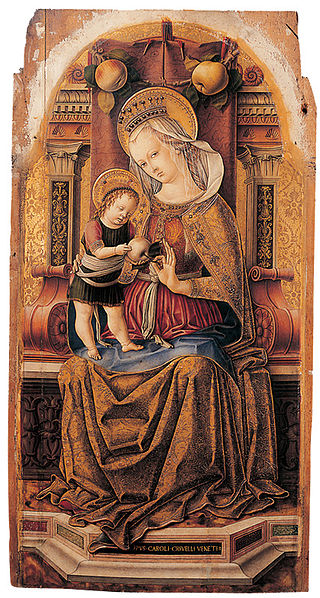
Andrea Mantegna was an Italian painter, a student of Roman archeology, and son-in-law of Jacopo Bellini.

Luca Signorelli was an Italian Renaissance painter from Cortona, in Tuscany, who was noted in particular for his ability as a draftsman and his use of foreshortening. His massive frescos of the Last Judgment (1499–1503) in Orvieto Cathedral are considered his masterpiece.

Lorenzo Lotto was an Italian painter, draughtsman, and illustrator, traditionally placed in the Venetian school, though much of his career was spent in other north Italian cities. He painted mainly altarpieces, religious subjects and portraits. He was active during the High Renaissance and the first half of the Mannerist period, but his work maintained a generally similar High Renaissance style throughout his career, although his nervous and eccentric posings and distortions represented a transitional stage to the Florentine and Roman Mannerists.

Pietro Perugino, an Italian Renaissance painter of the Umbrian school, developed some of the qualities that found classic expression in the High Renaissance. Raphael became his most famous pupil.

Carlo Crivelli was an Italian Renaissance painter of conservative Late Gothic decorative sensibility, who spent his early years in the Veneto, where he absorbed influences from the Vivarini, Squarcione, and Mantegna. He left the Veneto by 1458 and spent most of the remainder of his career in the March of Ancona, where he developed a distinctive personal style that contrasts with that of his Venetian contemporary Giovanni Bellini.

Giovanni Battista Cima, also called Cima da Conegliano, was an Italian Renaissance painter, who mostly worked in Venice. He can be considered part of the Venetian school, though he was also influenced by Antonello da Messina, in the emphasis he gives to landscape backgrounds and the tranquil atmosphere of his works.

Vincenzo Foppa was an Italian painter from the Renaissance period. While few of his works survive, he was an esteemed and influential painter during his time and is considered the preeminent leader of the Early Lombard School. He spent his career working for the Sforza family, Dukes of Milan, in Pavia, as well as various other patrons throughout Lombardy and Liguria. He lived and worked in his native Brescia during his later years.
Sano di Pietro or Ansano di Pietro di Mencio (1405–1481) was an Italian painter of the Sienese school of painting. He was active for about half a century during the Quattrocento period, and his contemporaries included Giovanni di Paolo and Sassetta.

Giampietrino, probably Giovanni Pietro Rizzoli, was a north Italian painter of the Lombard school and Leonardo's circle, succinctly characterized by S. J. Freedberg as an "exploiter of Leonardo's repertory."

Biagio d’Antonio Tucci was an Italian Renaissance painter active in Florence, Faenza and Rome.

The Pinacoteca del Castello Sforzesco is an art gallery in the museum complex of the Castello Sforzesco in Milan, northern Italy.

The San Pietro Polyptych is a polyptych by Italian Renaissance master Perugino, painted around 1496–1500. The panels are now in different locations: the lunette and the central panel, depicting the Ascension of Christ, are in the Museum of Fine Arts of Lyon, France.

The Bolognini Madonna is an oil-on-panel painting executed ca. 1514–1519 by the Italian Renaissance painter Antonio da Correggio.

The St Peter Martyr Altarpiece or Minor San Domenico Altarpiece is a altarpiece in tempera and gold on panel by the Italian Renaissance painter Carlo Crivelli, executed c. 1476. Its central panel of the Madonna and Child, signed "OPVS CAROLI CRIVELLI VENETI", is now in the Museum of Fine Arts in Budapest. The altarpiece's other panels were seen in Rome by Luigi Lanzi in 1789 before being moved to Florence with the Rinuccini family. In 1868 it moved from the Demidov collection to the National Gallery in London, where they still hang.

The 1476 Altarpiece or San Domenico Altarpiece is a 1476 tempera and gold on panel altarpiece by Carlo Crivelli. Its central panel of the Pietà is now in the Metropolitan Museum of Art in New York, whilst the other nine are now in the National Gallery, London.

The Massa Fermana Altarpiece is a 1468 tempera and gold on panel by Carlo Crivelli, held in Santi Lorenzo e Silvestro church in the town of Massa Fermana. It is signed "KAROLVS CRIVELLVS VENETVS PINXIT HOC OPVS MCCCCLXVIII". It is his earliest known surviving work and is notable for dating his return to Italy.

The Roverella Altarpiece was a religious painting by Cosmè Tura completed during 1470–1474 using oil and egg-tempera on poplar panel work, commissioned by abbot and cardinal Bartolomeo Roverella for San Giorgio fuori le mura in Ferrara in memory of his brother bishop Lorenzo Roverella. It was one of the most significant works of the artist and of the Ferrara Renaissance in general. It was damaged in an explosion in 1709 and moved out of the church. It is now dismembered and their panels split up between several museums.

The San Domenico di Pesaro Altarpiece is an oil-on-panel painting created ca. 1524–1526 by the Italian Renaissance artist Giovanni Girolamo Savoldo, now in the Pinacoteca di Brera, in Milan. The work dates to the same period as Savoldo's Rest on the Flight into Egypt, also produced for San Domenico. It shows the Madonna and Child seated between two angel musicians, while in the lower register it shows Saint Peter, Saint Dominic, Saint Paul and Saint Jerome.

The Porto San Giorgio Altarpiece or Porto San Giorgio Polytpych was a 1470 multi-panel tempera and gold on panel altarpiece by the Italian Renaissance painter Carlo Crivelli. Stylistically similar to Crivelli's Massa Fermana Altarpiece, the work was a fundamental step in his evolution away from the Paduan Renaissance towards a more delicate and realist style.





























